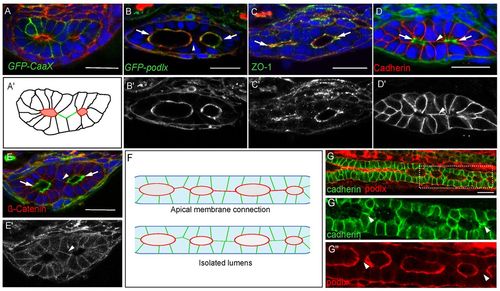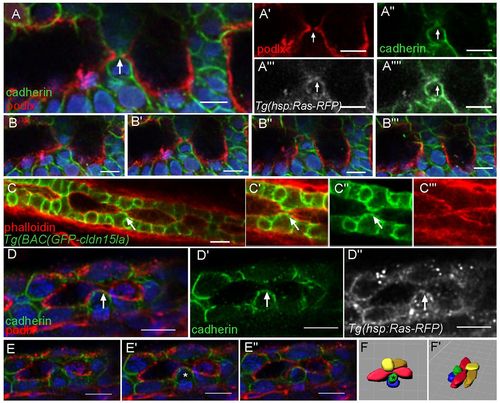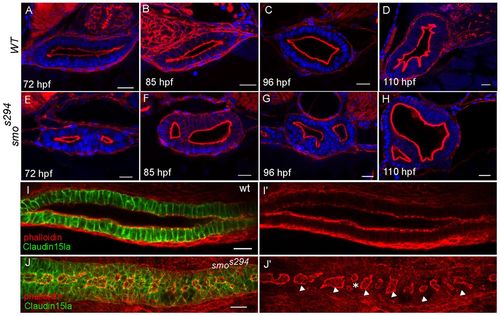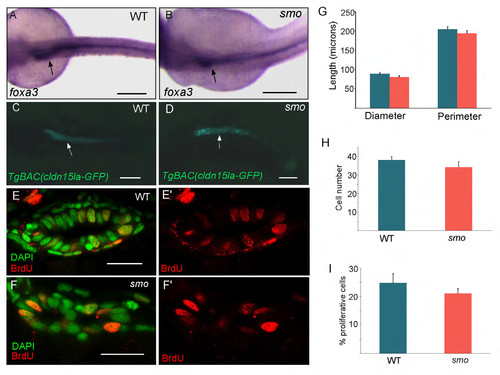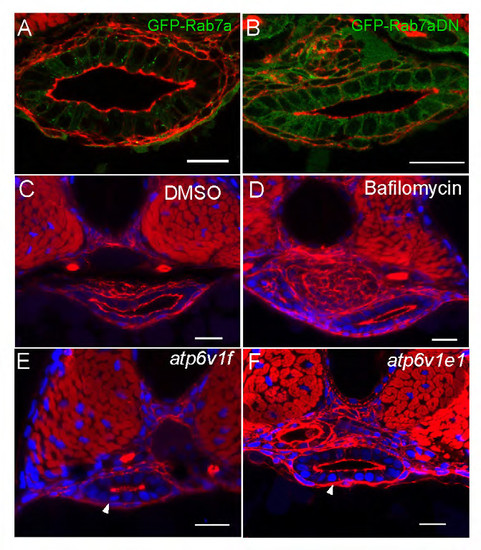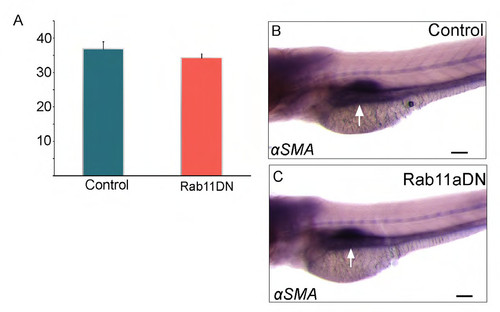- Title
-
Single continuous lumen formation in the zebrafish gut is mediated by smoothened-dependent tissue remodeling
- Authors
- Alvers, A.L., Ryan, S., Scherz, P.J., Huisken, J., and Bagnat, M.
- Source
- Full text @ Development
|
Lumens enlarge and fuse during single lumen formation in the zebrafish gut. (A-C) Confocal images of cross sections of wild-type embryos exhibiting class I (A), class II (B) and class III (C) lumens, stained with phalloidin. Arrowheads indicate the lumens. (D) Quantification of lumen phenotypes between 48 and 72 hpf: 48 hpf n=21, 52 hpf n=29, 56 hpf n=27, 60 hpf n=27, 64 hpf n=30, 68 hpf n=21, 72 hpf n=26. (E) Space-fill projection from a 200 7μm confocal stack of an intestine section at the resolution stage. Yellow, lumen; green, GFP-CaaX; blue, DAPI. (F) Confocal whole-mount image of the anterior gut at 58 hpf stained with phalloidin (red). Arrowheads point to adjacent unfused lumens. (G) Confocal whole-mount image of the posterior gut at 58 hpf stained with phalloidin (red). Arrowheads point to lumens. Scale bars: 20 μm in A-C; 10 μm in E; 20 μm in F,G. |
|
Generation of an intestine-specific transgenic line. (A,B) Dorsal, top panel, and lateral view, bottom panel, in situ hybridization showing claudin 15-like a expressed specifically in the intestine at 56 hpf. (C) Schematic of TgBAC(cldn15la-GFP) generation. The recombination target is shown on top, and the expected protein structure is shown on the bottom. (D) Confocal cross-section of a 72 hpf TgBAC(cldn15la-GFP) embryo. (E) Magnification of box from D. (F) Immunolocalization of Cldn15la to the basolateral membranes of intestinal epithelial cells. (G,H) Whole-mount fluorescent images of 55 hpf and 75 hpf embryos expressing TgBAC(cldn15la-GFP). Arrows indicate the gut tube. (I-L) Live imaging of TgBAC(cldn15la-GFP) using SPIM. Snapshots from a single plane from 48-70 hpf. Arrowheads indicate lumens; arrows point to cell-cell contacts between lumens. (M) Stitched confocal whole-mount images of a TgBAC(cldn15la-GFP) embryo show unfused lumens (arrowhead) in the posterior intestine at 68 hpf that are separated by cell-cell contacts (arrow). (N) Magnification of cell-cell contacts from M. Arrows indicate contacts. Phalloidin (red). Scale bars: 50 μm in D-F; 20 μm in M,N. EXPRESSION / LABELING:
|
|
Cell-cell contacts are found between lumens. (A-E) Confocal cross sections of embryos at the lumen resolution stage. (A) Tg(hsp70l:GFP-CaaX) labels all cell membranes. (A2) Cartoon diagram of Fig. 3A depicting laterally arranged lumens in red and ?bridge? contacts in green. (B,B2) Apical protein, GFP-Podocalyxin surrounds the lumen but is not found at bridge contacts. Phalloidin (red). (C,C2) Antibody staining against Zo-1 labels tight junctions. Phalloidin (red). (D-E2) Antibody staining against cadherin and β-catenin labels basolateral contacts and ?bridge? contacts between lumens. Phalloidin (green). (F) Cartoon depicting two scenarios of lumen fusion along the AP axis. Apical membrane (red) can be deposited on membranes between lumens (top) or lumens may arise isolated and fuse directly without an apical membrane linker (bottom). (G-G2) Whole-mount confocal image of a lumen resolution stage embryo expressing GFP-Podocalyxin (red) and stained for cadherin in green. Cadherin localizes to basolateral contacts separating lumens. Arrows indicate lumens; arrowheads indicate bridge contact. Scale bars: 20 μm. EXPRESSION / LABELING:
|
|
Basolateral adhesions separate lumens along the AP axis. (A-A22) Whole-mount confocal image of an embryo expressing GFP-Podocalyxin (false colored in red) and stained for cadherin (green) shows luminal expansion during a fusion event. Ras-RFP (white) marks cell membranes. Arrows mark fusion event. Blue, DAPI. (B-B22) Optical sections from a z-stack surrounding a fusion event. (C-C2) Whole-mount confocal image of a TgBAC(GFP-cldn15la) embryo shows a putative adhesion snapping event during fusion. The arrow marks adhesion at the surface. (D-D2) Whole-mount confocal image of an embryo expressing GFP-Podocalyxin (red) and stained for cadherin (green) shows adhesion snapping during fusion. Ras-RFP (white) marks cell membranes. The arrow marks adhesion at the surface. (E-E2) Optical sections from z-stack surrounding a fusion event. The asterisk marks a cell with adhesion. (F,F2) Space-fill projection labeling cells surrounding the fusion event. Lumen, red. The asterisk marks a cell with adhesion. Scale bars: 10 μm. EXPRESSION / LABELING:
|
|
smos294 mutants exhibit a lumen fusion defect. (A-H) Confocal cross sections of wild-type (top) and smos294 (bottom) intestines at 72 hpf, 85 hpf, 96 hpf and 110 hpf. Phalloidin (red). (I,J) Confocal whole-mount image of wild-type and smos294 embryos expressing TgBAC(cldn15la-GFP) to highlight the cellular and luminal architecture of the intestine at 72 hpf. (I) Wild-type intestine, (J) smos294 intestine. Arrowheads, lumens; asterisk, adjacent lumens. Scale bars: 20 μm. EXPRESSION / LABELING:
PHENOTYPE:
|
|
Rab11 is abnormally localized in smos294 mutants. (A,A2) Confocal cross section of a Tg(hsp70l:gal4); Tg(UAS:rab11aS25N) embryo. Phalloidin (green). (B,B2) Confocal cross section of a Tg(hsp70l:rab11bS25N) embryo. Phalloidin (red) (C,D) Confocal cross sections of smos294 and wild-type clutchmates expressing Tg(hsp70l:GFP-RAB11a). Arrowheads point to abnormal enlarged Rab11 positive vesicles in smos294. Phalloidin (red) (E-H) Confocal cross section of wild-type and smos294 embryos expressing Tg(hsp70l:GFP-RAB11a) stained for the apical marker 4e8 (E,F) or cadherin (G,H). Arrowheads point to areas of colocalization. (I,J) Confocal cross sections of uninjected and RFP-Rab11fipa1-injected Tg(hsp70l:GFP-RAB11a) embryos. Arrowheads point to dispersed compartments. (K) Expression levels of Rab11 family members in the intestinal epithelium of smos294 mutants relative to wild-type clutchmates. Rab11fip1a P<0.011, n=3. All embryos are 72 hpf. Scale bars: 20 μm. EXPRESSION / LABELING:
PHENOTYPE:
|
|
smoothened signaling acts in the surrounding mesenchyme. (A,B) Confocal cross section of the transcriptional reporter Tg(GBS-ptch2:EGFP)umz23. Phalloidin (red), DAPI (blue). Scale bar: 20 μm. (C) Hh is expressed in the epithelium and binds to ptch in the mesenchyme to activate smo mediated downstream transcription. Thus, smo regulates the epithelium through epithelial-mesenchymal signaling pathways. (D,E) Dorsal view of an in situ hybridization showing αSMA expression in WT and smo mutant embryos at 72 hpf. Arrows point to smooth muscle. Scale bar: 100 μm. |
|
Gut tube shape and total cell number are similar in wildtype and mutant embryos. (A,B) In situ hybridization of WT and smo mutant embryos expressing foxa3 at 30 hpf. Scale bar: 200 μm. (C-D) WT and smo mutant embryo expressing TgBAC(cldn15la-GFP) at 48 hpf. Arrows indicate intestine. (E-F2) Cross section of WT and smo mutant guts at 72 hpf stained for BrdU to label proliferating cells. Scale bars: 20 μm. (G) Quantification of the diameter and perimeter of WT and smo mutant guts from transverse cross sections. Wt n=14, mutant n=18, diameter P>0.18, perimeter P>0.48. (H) Quantification of total cell number in WT and mutant guts. WT n=14, mutant n=18, P>0.30 (I) Quantification of the percent of BrdU positive cells in WT and smo mutant guts. WT n=14, mutant n=19, P>0.32. PHENOTYPE:
|
|
The degradation pathway is not involved in lumen formation. (A,B) Confocal cross sections from Tg(hsp70l:GFP-Rab7) and Tg(hsp70l:GFP-Rab7DN) embryos. Phalloidin (red). (C,D) Confocal cross sections from DMSO and bafilomycin treated embryos. (E,F) Confocal cross sections from atp6 v1f and atp3v1e mutant embryos. Phalloidin (red). Scale bars: 20 μm. |
|
Apical and basolateral proteins colocalize with Rab11aDN compartments. (A-E) Confocal cross section of a WT and Rab11aDN embryos at 72 hpf stained for cadherin. Arrowheads point to Rab11DN and cadherin co-localization in internal compartments. (F-J) Confocal cross section of a WT and Rab11aDN embryos at 72 hpf stained for 4e8. Arrowheads point to Rab11DN and 4e8 co-localization in internal compartments Scale bars: 20 μm |
|
Cell number and mesenchymal differentiation is not impaired in Rab11DN embryos. (A) Quantification of total cell number in the gut in WT and Rab11aDN embryos. WT n=13, DN n=11, P>0.32. (B,C) Lateral view of an in situ hybridization showing αSMA expression in WT and Rab11aDN embryos at 72 hpf. Arrow points to smooth muscle. Scale bar: 100 μm. (D-E′′) Confocal section of WT and Rab11DN embryo stained for Myh11. Arrowhead points to Mhy11 in the mesenchyme. Asterisk indicates non-specific epithelial staining as observed previously (Wallace et al., 2005). Scale bar: 20 μm. |



